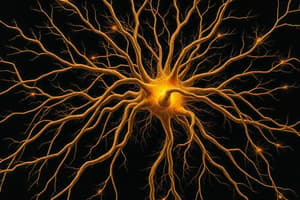Podcast
Questions and Answers
What is the basic building block of the nervous system?
What is the basic building block of the nervous system?
neurons
What are the three broad classes of neurons?
What are the three broad classes of neurons?
sensory neurons, interneurons, and motor neurons
What type of neurons carry information from the body's organs and tissues to the CNS?
What type of neurons carry information from the body's organs and tissues to the CNS?
sensory neurons
Where can interneurons be found?
Where can interneurons be found?
What links sensory and motor neurons?
What links sensory and motor neurons?
What do interneurons do?
What do interneurons do?
What carries instructions from the central nervous system to muscles?
What carries instructions from the central nervous system to muscles?
What part of the neuron receives messages from other neurons?
What part of the neuron receives messages from other neurons?
What part of the neuron is specialized for sending impulses?
What part of the neuron is specialized for sending impulses?
What is another word for the soma?
What is another word for the soma?
Which part of the neuron is most closely associated with the speed of impulse conveyance?
Which part of the neuron is most closely associated with the speed of impulse conveyance?
An axon can range in length from a fraction of an inch to?
An axon can range in length from a fraction of an inch to?
What is only found in the intercellular fluid?
What is only found in the intercellular fluid?
Which type of ions have a negative charge in the extracellular fluid?
Which type of ions have a negative charge in the extracellular fluid?
In its resting state, an axon has?
In its resting state, an axon has?
The movement of ____ and ____ through the membrane is most central to action potentials.
The movement of ____ and ____ through the membrane is most central to action potentials.
Sodium ions are more concentrated in the ___ while potassium ions are more concentrated in the ____.
Sodium ions are more concentrated in the ___ while potassium ions are more concentrated in the ____.
What pushes ions through the membrane?
What pushes ions through the membrane?
When a neuron fires, ___ rush into the axon and make that part of the axon more ____ charged.
When a neuron fires, ___ rush into the axon and make that part of the axon more ____ charged.
The ___ charge of one section of an axon causes the ___ of the next section to open.
The ___ charge of one section of an axon causes the ___ of the next section to open.
An action potential is comprised of a series of?
An action potential is comprised of a series of?
The membrane is repolarized when gates open and ___ flow out of the axon.
The membrane is repolarized when gates open and ___ flow out of the axon.
What do synaptic vesicles contain?
What do synaptic vesicles contain?
From where are neurotransmitters released?
From where are neurotransmitters released?
Where are neurotransmitters released into?
Where are neurotransmitters released into?
Flashcards are hidden until you start studying
Study Notes
Neurons and Their Functions
- Neurons serve as the fundamental building blocks of the nervous system, essential for transmitting signals.
- Three main types of neurons include sensory neurons (carry information to the CNS), interneurons (process information), and motor neurons (send instructions from the CNS).
- Interneurons are exclusively located in the brain and spinal cord, linking sensory and motor neurons.
Specific Neuronal Functions
- Sensory neurons transport information from organs and tissues to the central nervous system.
- Motor neurons convey instructions from the central nervous system to muscles.
- Interneurons, located within the brain and spinal cord, process sensory input and facilitate responses.
Structure of Neurons
- Dendrites are the parts of a neuron that receive incoming messages.
- Axons are specialized for transmitting impulses away from the neuron.
- The cell body, also known as the soma, contains the nucleus and organelles necessary for the neuron's functions.
- Myelin sheath significantly increases the speed of impulse transmission along the axon.
Electrical Properties of Neurons
- Axon length can vary from a fraction of an inch to several feet.
- In the resting state, axons have a larger concentration of negative particles inside than outside.
- Action potentials are driven by the movement of sodium and potassium ions through the neuron's membrane.
Ion Concentration and Action Potentials
- Sodium ions dominate in the extracellular fluid, while potassium ions are more prevalent in the intracellular fluid.
- The sodium and potassium pumps are responsible for actively transporting ions across the membrane.
- When a neuron fires, sodium ions influx raises the internal charge, creating a positive charge within the axon.
Propagation of Action Potentials
- The positive charge in one segment of the axon triggers the sodium gates of the adjacent segment to open, allowing action potentials to propagate.
- An action potential encompasses a series of depolarizations and is followed by repolarization, during which potassium ions flow out of the axon.
Synaptic Transmission
- Synaptic vesicles store neurotransmitters, which are crucial for neuron-to-neuron communication.
- Upon arrival of an action potential, neurotransmitters are released from synaptic vesicles into the synaptic gap, facilitating signal transmission to adjacent neurons.
Studying That Suits You
Use AI to generate personalized quizzes and flashcards to suit your learning preferences.




